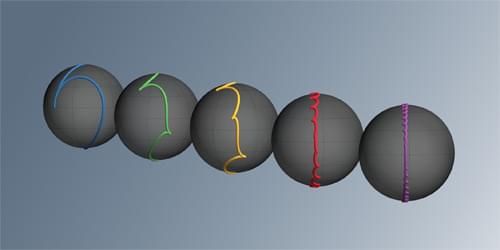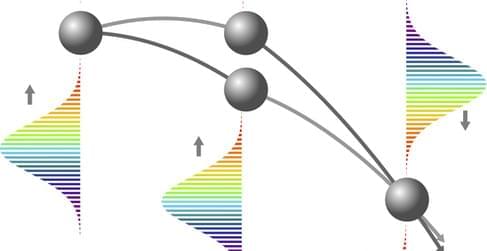A massive burst of gamma radiation hit Earth, likely from a new black hole. There’s no threat, but we can’t rule out more Hulks.



The engineering of so-called Floquet states leads to almost-perfect atom-optics elements for matter-wave interferometers—which could boost these devices’ ability to probe new physics.
Since Michelson and Morley’s famous experiment to detect the “luminiferous aether,” optical interferometry has offered valuable tools for studying fundamental physics. Nowadays, cutting-edge applications of the technique include its use as a high-precision ruler for detecting gravitational waves (see Focus: The Moon as a Gravitational-Wave Detector) and as a platform for quantum computing (see Viewpoint: Quantum Leap for Quantum Primacy). But as methods for cooling and controlling atoms have advanced, a new kind of interferometer has become available, in which light waves are replaced by matter waves [1]. Such devices can measure inertial forces with a sensitivity even greater than that of optical interferometers [2] and could reveal new physics beyond the standard model.

A multiwavelength laser source known as a frequency comb provides a new technique for atom interferometry, potentially leading to new tests of fundamental physics.
In atom interferometry, researchers use the interference of quantum waves of matter, often for high-precision experiments testing fundamental physics principles. A research team has now demonstrated a new way to produce matter-wave interference by using a frequency-comb laser—a comb-like set of spectral lines at regularly spaced frequencies [1]. The comb allowed the team to generate interference in a cloud of cold atoms. The method might ultimately be used to investigate differences between matter and antimatter.
According to the weak equivalence principle, gravity must cause both matter and antimatter to fall at the same rate (see the graphical explanation, The Equivalence Principle under a MICROSCOPE). Deviations from this principle could point to explanations for the hitherto mysterious imbalance in the amounts of matter and antimatter in the Universe. Atom interferometry could provide a test of weak equivalence through precise measurements of the free fall of antihydrogen. So far, light-based control of atom interferometry has used continuous-wave (cw) lasers [2], which can’t easily be extended to the short wavelengths in the extreme ultraviolet (XUV) that are needed for such studies of antihydrogen.
NVIDIA’s Megatron Turing AI Model can now have conversations with itself to perpetually improve itself in the hopes of understanding how to best control and influence other people in debates. This sparked a lot of discussions in the AI Community because ever-improving Artificial Intelligences pose real dangers to humanity.
–
TIMESTAMPS:
00:00 The biggest Black Box.
01:54 Nvidia’s GPT-3 Competitor.
03:23 How these AI’s work.
04:50 The Ethical issues of Black Box AI’s.
08:19 Last Words.
–
#ai #agi #nvidia

A new way to boost the growth of plants in rooftop farms.
Humans constantly breathe out large amounts of CO2 and when we are inside a building for a period of time, it creates high concentrations of carbon dioxide inside the building. This CO2 is removed through a building’s exhaust system.
Plants take in CO2 as a source of food and when they are exposed to lots of CO2, they will grow bigger than they would have otherwise.
Dr. Sarabeth Buckley.
Interestingly, a team of researchers from Boston University has proposed a system called BIG GRO in which excess CO2 from a building’s exhaust system can be utilized as a fertilizer to grow thriving rooftop gardens.

Researchers say they were inspired by living things from trees to shellfish.
They were inspired by living things, from trees to shellfish. Researchers at the University of Texas at Austin set their collective advanced minds on creating a plastic that would mimic real life. It would be like many life forms that are soft and stretchy in some places and hard and rigid in others.
Their success, a first ever, using only light and a catalyst to change the properties such as hardness and elasticity in molecules of the same type. The resulting material is ten times stronger than natural rubber and could very well change flexibility of electronics and robotics.
Plastic stretch.
The findings were published recently in the journal Science.
Bill Gates founded Breakthrough Energy and has recently announced that its first Catalyst project funding will come in the form of a $50 million grant to LanzaJet’s Freedom Pines Fuels sustainable aviation fuel (SAF) plant in Soperton, Georgia.
Breakthrough Energy Catalyst is a unique program that brings together businesses and nonprofits to fund key first-of-its-kind commercial-scale projects that speed up the deployment of essential technologies.

Researchers created an artificial intelligence process that determines when and where wildfires will occur.
Wildfires have caused extreme fire damages across the globe, along with many deaths. It is significant to know when wildfires are spreading, and where, to prevent loss of life. Realizing this important information in advance is key. Forecasting wildfire danger can be a difficult task because of the complexity involving climate system, interactions with vegetation and socio-economic components.
Currently, available information for widespread fires only provides limited data and information.
Pixabay / Clandestino.
New method.

They also discovered the earliest proof of the moment when the planet’s magnetic poles switched places.
The Earth’s crust was pushing and tugging like present plate tectonics at least 3.25 billion years ago, according to new research published today (Oct .24) in PNAS, which examined fragments of the most ancient rocks on the planet.
The research also offers the oldest evidence of the moment when the planet’s magnetic north and south poles switched places.
The two findings provide hints as to how such geological changes may have produced a planet with a more favorable environment for the emergence of life.